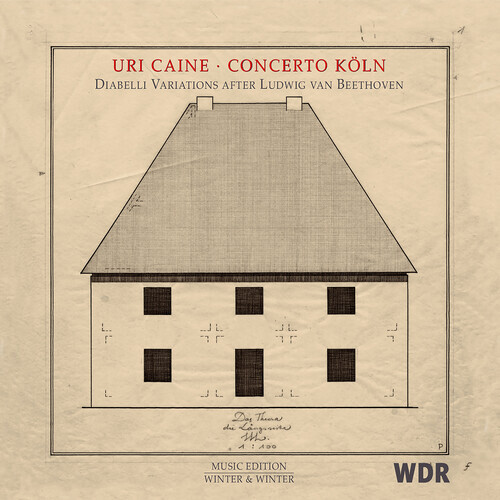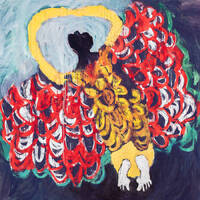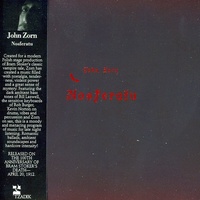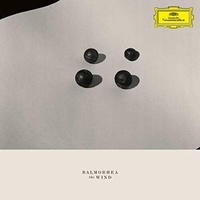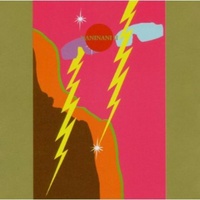Uri Caine - Concerto Koln - Diabelli Variations after Ludwig Van Beethoven
Reissue 2020
When Anton Diabelli, wishing to promote himself as a publisher, commissioned many of the best-known composers of his time to write a variation on a theme composed by himself in 1819 in order to publish a score with all of them, he couldn't possibly imagine that the greatest of them all, Ludwig van Beethoven, was going to write not one, but thirty-three variations, probably encouraged by his wish to keep his name apart from his minor colleagues or, who knows, by his eagerness to undertake an in-depth search of the possibilities of a theme that, initially, he scornfully mocked for its 'Schusterfleck' ('cobbler's patch'). In the end, in his Diabelli Variations Beethoven turned the banal (that tiny waltzlet serving as the starting point) into transcendent. From hardly nothing he built a whole which overwhelms us with its greatness. It's a work full of paradoxes, winks, double meanings, but it's also a contested work, not easily understandable, complex and experimental. Planned as a building with superimposed layers, seemingly heterogeneous and without an apparent connecting thread, it looks the perfect testing ground for a creative artist – like Uri Caine. In his hands you forget the quasi-monotonal character of the piece, and we remain drawn and surprised by its continuous feinting.
After Mahler, Wagner, Schumann, and Bach, Uri Caine faces now another major challenge - the music of a composer who has become the innovator par excellence of the Western musical tradition. The late works by Beethoven entail a special risk, because in his last years the composer secluded himself in an inner, hardly accessible world. His works became true inner monologues, and he was the only person who knew the keys to understand their meaning. If you expect Uri Caine to mimic here his approach to Bach's Goldberg Variations, you will be greatly surprised. His Bach was a huge summary of musical styles, and literal Bach lived side to side with a whole array of musical languages, genres and forms. His Beethoven, though, is true Beethoven from beginning to end. When you play with an orchestra (Concerto Köln, one of the best ensembles of its kind), with written-out parts, there is less room for adventurous trips. In spite of that, Uri manages to make an adventure of his friendly appropriation of Beethoven's Diabelli Variations.
Why an adventure? When you think of Uri Caine and Concerto Köln playing on the same stage, or recording in the same studio, the first thing that comes into your head is a sort of piano concerto. Are Uri's Diabelli Variations a piano concerto? By no means. In the course of their joint journey, piano and orchestra dialogue, argue, get together, get apart, joke, play, keep silent… But the piano is never a soloist, and the orchestra is not a supporting actor. Both need each other, and both show different ways to interact with each other. Sometimes they form a complex together (Variation XII); sometimes the piano finds its way into the orchestral texture, adding a new, original voice (Variation XX); sometimes the piano plays alone, usually in couples of variations (Variations V-VI, XVI-XVII); sometimes Uri, playing briefly the role of a conductor, substitutes his own voice for the piano (Variation XIII); the orchestra remains faithful to Beethoven's letter, but the piano often chooses to be faithful to the spirit.
The distinct character of every variation, and the original formal plan, remain unchanged (only original Variations VII and XXVII are altogether omitted). The echo of the waltz - its harmonies, its melodic contour - is always present in the piano improvisations, which we hear as the choruses in a jazz piece, and amazingly enough, Uri manages to blend in a miraculous way jazz language and Beethoven's peculiar and unmistakable late style. Variation XXXI, the customary variation minore, here essentially unchanged, becomes in this way a common territory, where both languages (Beethoven's and Caine's) easily intertwine. When Uri decides to explore new territories, he never forgets where he comes from, or the next stage awaiting him shortly afterwards. Long excursions are out of place here, and Uri knows it. That is the reason why every variation lasts essentially the same as in Beethoven's original. With indiscriminate piano ruminations, the whole would suffer, and the building would inevitably collapse. What we hear instead is a solid construction, where humour becomes intensified (the already mentioned Variation XIII, or the parody of Leporello's opening aria in Don Giovanni in Variation XXII, with Uri adding new, longer runs to the orchestral triplets), but also where high counterpoint sounds as strict, necessary, deep, and emotional as in Beethoven's (Variations XXIV & XXXII; Uri adds in the latter his own, extraordinary cadenza after the fermata, with its final, surprising quotation of the 'Moonlight' Sonata). The late works by Beethoven are inconceivable without this counterpoint effusiveness, and Uri knows this too.
As it happened in all Uri's approaches to classical music, his Diabelli Variations are a surprising combination of past and present. The fact that he has chosen to play, like the members of Concerto Köln, a period instrument (a wonderful piano built by Erard in 1839) is in itself a declaration of intent. Uri has also decided, as orthodoxy claims, to follow every repeat sign, but his 'chorus' never reappears again in the same form – structure remains, but superstructures change once and again. Last but not least, it is also significant that he has introduced a couple of variations for piano solo (after original Variations V & XXII) where he applies Beethoven's procedures to well-known themes of his Symphonies nos. 1 & 5. Just listen to the preceding variations, and you will understand why.
Winter & Winter's decision to include Paul Schmitthenner's variations on a house is the best possible way to illustrate Uri's Diabelli Variations. Both speak the same language, no matter if thoughts are expressed with lines or with notes. Both start from a germinal idea, both renounce virtuosity, and both arrive at similar conclusions. Reality may look always the same, but it is always different. Fortunately enough, in spite of the enormous weight of his name and his legacy, Uri explores Beethoven's path as he has always done, unprejudiced and without fear to what orthodox, generally narrow-minded, people might think. To say it with Beethoven's own words (in a letter to Archduke Rudolph): "In the world of art … freedom and progress are the main objectives."
- Luis Gago
![]()
(025091026524)
| SKU | 025091026524 |
| Barcode # | 025091026524 |
| Brand | Winter&Winter |
Be The First To Review This Product!
Help other Birdland Records users shop smarter by writing reviews for products you have purchased.

